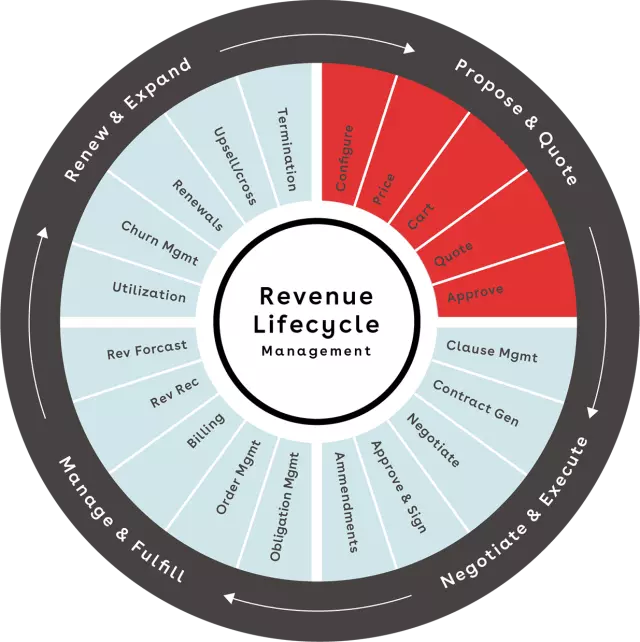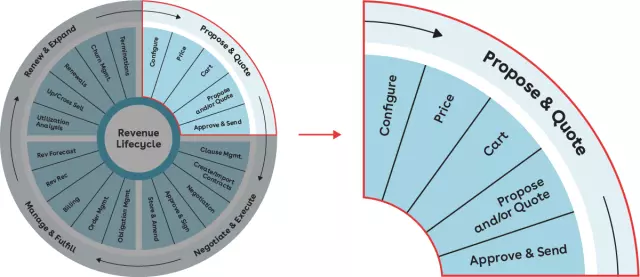
Navigating the omnichannel revolution in manufacturing

In today's rapidly evolving landscape of B2B interactions, customers are increasingly demanding a seamless, personalized, and consistent buying experience across every touchpoint. This shift is driven by the proliferation of multiple channels for engaging with and making purchases from manufacturers.
Research highlights that B2B customers are enthusiastically embracing digital self-service channels, with a preference for online interactions. A remarkable 60% of B2B customers find buying products online to be more convenient than going through traditional channels, and 62% express a clear preference for reordering products online.
There is a critical need for manufacturers to adapt to the evolving digital landscape and prioritize seamless digital buying experiences to meet the ever-rising expectations of their customers.
The benefits of omnichannel for manufacturers
Manufacturers have also seen the benefits of embracing an omnichannel approach. For those with an established eCommerce selling strategy, the majority reported that half of their overall revenue was generated through online sales channels. A significant 42% of manufacturers who have invested in eCommerce and digital technologies acknowledge their improvement in customer relationships as a direct result of this investment.
Omnichannel challenges
Yet, creating a truly seamless omnichannel experience is no small feat. Internally, manufacturers grapple with the challenge of managing an array of channels, including distributors, partners, eCommerce platforms, and direct-to-consumer (DTC) outlets—all while striving to create a unified and seamless omnichannel experience.
Externally, customers often navigate a complex buying journey, frequently starting and stopping their engagement through different channels. This intricate and evolving landscape underscores the critical importance of adopting a comprehensive and adaptive omnichannel approach.
Only 13% of industrial OEMs provide digital solutions of any kind, and just 10% offer convenient online self-service tools for reordering. Clearly, there's a significant gap between the rising demand for omnichannel experiences and manufacturers' current capabilities. To remain competitive in this dynamic landscape, manufacturers must craft a well-rounded omnichannel strategy tailored to the unique needs of their customers.
Creating an omnichannel strategy
For manufacturers to keep up with their customers and attract new business through omnichannel experiences, they need to focus on three key areas:
1. Creating a seamless customer experience across all channels
Manufacturers must ensure that there is one engine driving all pricing and configuration options across all channels, whether that’s online, through a sales rep, or via a partner seller. The goal is for the omnichannel experience to feel natural, with no disruptions or inconsistencies—i.e., it's working, and customers don't even realize it's there.
2. Configuring products online with real-time pricing
Manufacturers need to make configuring and pricing products easy to do regardless of channel. This includes the need to clarify complex products and make them easier to purchase or create guardrails to ensure solutions are configured accurately every time. This is particularly crucial for manufacturers with complex, highly configurable products. Customers should receive a consistent product configuration and pricing experience across all touchpoints.
3. Leveraging data for personalization and integration
The single engine that drives consistent pricing and configuration across all channels requires a unified data model. This is crucial for manufacturers to also unlock revenue intelligence to provide more personalized experiences for customers, like recommendations based on past purchases and browsing behavior, thereby increasing cross-selling and upselling opportunities.
Revenue Lifecycle Management: the path to your omnichannel strategy
To navigate the complex world of omnichannel experiences successfully, businesses enlist Revenue Lifecycle Management processes. Omnichannel selling necessitates the effective management of every revenue-generating customer journey stage, and Revenue Lifecycle Management plays a pivotal role in achieving this.

Revenue Lifecycle Management involves aligning all teams, processes, and systems to drive operational excellence across all revenue-generating experiences. The ultimate goal is to deliver profitable growth and increased customer lifetime value. In an omnichannel strategy, businesses interact with customers through multiple touchpoints, including distributors, partners, eCommerce sites, retailers, and more. Revenue Lifecycle Management ensures consistency in quoting, contracting, order processing, billing, upsells, cross-sells, and renewals across all these channels. It is undeniably pivotal to an omnichannel selling strategy because it empowers companies to effectively manage the entire customer journey across various channels, ultimately leading to increased revenue and long-term customer loyalty.
Benefits of Revenue Lifecycle Management for manufacturers
Managing revenue effectively is arguably the most important business process. The reinvention of the revenue lifecycle creates an opportunity for organizations to embrace complexity and deliver profitable growth at scale. Key benefits include:
1. Creating a scalable sales engine
Revenue Lifecycle Management creates a scalable sales engine through automated and intelligent processes that augment human capabilities to optimize processes, enabling individuals to focus on higher-value activities.
2. Generating seamless experiences
It breaks down siloes, encouraging cross-functional collaboration and aligning operations across functions to deliver seamless experiences to customers.
3. Ensuring revenue profitability
Revenue Lifecycle Management boosts profitable growth through operational excellence by instilling controls into the buying and selling processes and enabling pricing strategies to drive decision-making.
Omnichannel technology
Execution through a Configure, Price, Quote (CPQ) tool is a critical component of Revenue Lifecycle Management in driving omnichannel effectiveness. A CPQ system streamlines the entire sales quoting process, reducing errors, ensuring consistency, and providing valuable data and insights that contribute to revenue growth and profitability. It helps organizations optimize their revenue operations, from the initial quote to the first invoice, ensuring that revenue is maximized while maintaining pricing accuracy and compliance.

Key benefits of CPQ systems include:
- Configuration accuracy: ensure accurate configurations with guardrails that improve the accuracy of selling products and services, regardless of complexity.
- Quote efficiency: CPQ streamlines the quote generation process, translating into faster quotes, shorter sales cycles, and more predictable revenue.
- Cross-selling and upselling: recommend complementary products or upgrades based on customer configurations, increasing the average deal size and boosting revenue.
- Discount control: enforce discounting policies, ensuring discounts are applied strategically to meet revenue targets without excessive margin erosion.
- Data and analytics: CPQ systems provide data and insights into quoting trends, allowing for data-driven decisions on pricing and product offerings to optimize revenue.
- Contract management: integration with contract lifecycle management tools ensures that contracts align with negotiated terms and pricing, reducing the risk of revenue leakage.
A CPQ system actively supports omnichannel experiences by providing a unified platform for configuring, pricing, and quoting products, ensuring consistency, personalization, and efficiency across all customer touchpoints. It effectively bridges the gaps between online and offline channels, creating a seamless and cohesive customer journey.
Key advantages of CPQ systems in the context of omnichannel experiences include:
- Consistency across channels: maintain consistency in product configurations, pricing, and quoting across all customer touchpoints, ensuring a seamless experience. These systems feed data into CRM and eCommerce platforms, enabling customers to initiate quotes or configurations on one channel and complete them on another, whether online or offline, with a distributor, directly with the OEM, or as self-service.
- Personalization and catalog management: a CPQ engine powers your omnichannel strategy by allowing for personalized catalogs, which can include product customizations or contracted pricing based on customer preferences or preexisting agreements. All these guardrails can be set up in advance.
A CPQ system is vital to Revenue Lifecycle Management and creating a seamless omnichannel experience. It ensures accuracy, efficiency, consistency, and personalization in pricing and quoting processes, all of which are essential for maximizing revenue. It also helps unify the customer experience across all channels, whether online or offline, by providing real-time information, personalized options, and seamless quoting capabilities. This convergence of efficient revenue management and omnichannel engagement is key to a successful and customer-centric business strategy in today's dynamic market.
We’ll help you meet your customers' needs
The journey toward mastering the art of omnichannel experiences in manufacturing is ongoing, but with the right tools, strategies, and a focus on the customer, businesses can thrive in this new era of B2B interactions.
That’s why businesses are turning to Conga, the leader in Revenue Lifecycle Management. Conga drives predictable revenue by aligning processes, teams, and technology under a unified data model throughout the revenue lifecycle. The Conga Revenue Lifecycle Cloud is a set of unified products that enable you to navigate your unique revenue lifecycle complexities and automate all revenue-generating processes to help you increase customer lifetime value. Conga CPQ is a critical component of the Conga Revenue Lifecycle Cloud that empowers sales, partners, and customers to efficiently configure complex product and service offerings. It provides personalized prices and quotes utilizing codified product and pricing information, ensuring higher win rates and a seamless buying experience.
We’ve helped our customers drive real business outcomes like:
- 38% faster time to quote
- 32% reduction in rogue discounting
- 22% increase in overall deal size
- 30% improvement in win rate
- 25% increase in sales revenue
Creating a seamless experience for your customers
We find ourselves amid a transformation that is reshaping the landscape of commerce. The process of purchasing goods and services is evolving into a more intricate journey, and consumers now want the convenience of buying through various channels. To thrive, organizations must explore innovative avenues to stimulate revenue expansion and grasp the full spectrum of possibilities. The future of commerce lies in embracing an omnichannel marketplace, which will pave the way for a unified and smooth customer journey throughout the entire revenue cycle rather than a disjointed and fragmented one. Ready to get started on your path to a better buying (and selling) experience? To see how we can revolutionize the way you do business, request a demo and we’ll customize a solution to meet your unique business needs.



